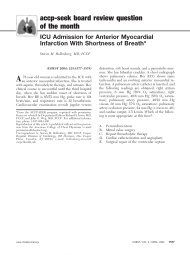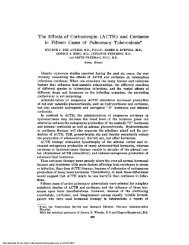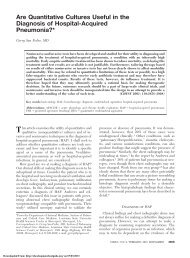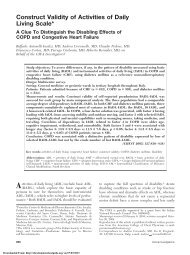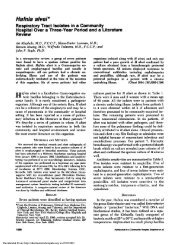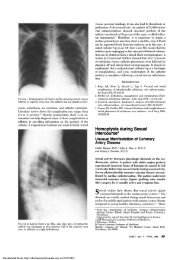Talc Preparations Used for Pleurodesis Vary Markedly From One ...
Talc Preparations Used for Pleurodesis Vary Markedly From One ...
Talc Preparations Used for Pleurodesis Vary Markedly From One ...
You also want an ePaper? Increase the reach of your titles
YUMPU automatically turns print PDFs into web optimized ePapers that Google loves.
<strong>Talc</strong> <strong>Preparations</strong> <strong>Used</strong> <strong>for</strong> <strong>Pleurodesis</strong><br />
<strong>Vary</strong> <strong>Markedly</strong> <strong>From</strong> <strong>One</strong> Preparation to<br />
Another*<br />
Jaume Ferrer, MD; Marian A. Villarino, MD; Josep M. Tura, PhD; and<br />
Adolf Traveria, PhD; and Richard W. Light, MD, FCCP<br />
Background: At the present time, talc is the one of the agents most commonly used <strong>for</strong> the<br />
production of a pleurodesis. However, there have been several recent reports of acute pneumonitis<br />
developing after the intrapleural administration of talc. The incidence of pneumonitis has<br />
varied markedly from center to center.<br />
Objective: To compare the physical characteristics of talc used <strong>for</strong> the production of pleurodesis<br />
in various localities.<br />
Design: Eight talc preparations (four from the United States, and one each from Brazil, France,<br />
Spain, and Taiwan) were analyzed <strong>for</strong> the distribution of the particle size and the type and<br />
amount of impurities.<br />
Measurements: The physical characteristics of the talc specimens were determined using<br />
radiograph diffraction and scanning electron microscopy.<br />
Results: The mean and median particle size varied by more than a factor of three among the eight<br />
different talc preparations. In addition, the impurities of the different talc preparations were<br />
quite varied.<br />
Conclusions: We conclude that there is marked variation in the physical characteristics of the talc<br />
preparations used intrapleurally <strong>for</strong> the production of a pleurodesis. We speculate that different<br />
incidences of acute pneumonitis at various centers after intrapleural administration of talc may<br />
be due to differences in the physical characteristics of the talc preparations used <strong>for</strong> pleurodesis.<br />
(CHEST 2001; 119:1901–1905)<br />
Key words: pleura; pleural effusion; pleurodesis; pneumothorax; talc<br />
At the present time, talc is one of the agents most<br />
commonly used <strong>for</strong> producing a pleurodesis in<br />
patients with either a spontaneous pneumothorax or<br />
a recurrent pleural effusion. There have been several<br />
reports of the ARDS occurring after talc is placed<br />
intrapleurally either as a slurry1–3 or as an insufflated<br />
powder. 4,5 Interestingly, most patients who have<br />
developed ARDS following talc administration have<br />
*<strong>From</strong> the Servei de Pneumologia (Drs. Ferrer and Villarino),<br />
Hospital Vall d’Hebron, Barcelona, Spain; the Consell Superior<br />
d’Investigacions Cientifiques (Dr. Tura), Barcelona, Spain; the<br />
Institut Jaume Almera (Dr. Traveria), Barcelona, Spain; and the<br />
Department of Medicine (Dr. Light), Saint Thomas Hospital and<br />
the Center <strong>for</strong> Lung Research, Vanderbilt University, Nashville,<br />
TN.<br />
Supported in part by the Saint Thomas Foundation, Nashville,<br />
TN.<br />
Dr. Ferrer and Dr. Villarino contributed equally to the design of<br />
the study and writing the article.<br />
Manuscript received October 13, 2000; revision accepted December<br />
15, 2000.<br />
Correspondence to: Richard W. Light, MD, FCCP, Director of<br />
Pulmonary Disease Program, Saint Thomas Hospital, PO Box<br />
380, 4220 Harding Rd, Nashville, TN; e-mail: RLIGHT98 @yahoo.com<br />
Downloaded <strong>From</strong>: http://chestioumal.chestpubs.org/ on 02/22/2013<br />
received talc from the United States. Two large<br />
series from Israel 6 and Europe 7 reported no instances<br />
of acute respiratory distress.<br />
It has been speculated that the acute lung injury is<br />
secondary to the extrapleural dissemination of the<br />
talc particles. 8 In the report of Milanez Campos and<br />
associates, 4 the talc from Brazil used in the study was<br />
found disseminated throughout the body of one<br />
patient after insufflation. Kennedy and associates 8<br />
reported that talc (Standard Chemicals; Chicago, IL)<br />
was found outside the pleural space in a substantial<br />
fraction of rabbits that were administered talc slurry.<br />
Werebe and coworkers administered talc slurry (the<br />
Brazilian talc used in the present study), 10 or 20 mg,<br />
intrapleurally to 40 rats and demonstrated that talc<br />
particles were found in both lungs, the chest wall,<br />
the liver, the kidney, the spleen, the heart, and the<br />
brain of all animals at 24 h and 48 h after injection. 9<br />
The varying prevalence in different countries of<br />
acute respiratory distress following talc intrapleurally<br />
suggests that the syndrome might be dependent on<br />
the talc preparation. However, there are no pub-<br />
CHEST / 119 /6/JUNE, 2001 1901
lished data on the physical and chemical characteristics<br />
of the various talc preparations used <strong>for</strong> pleurodesis.<br />
The purpose of the present study was to<br />
compare the composition and mean particle size of<br />
talc preparations used in various countries to produce<br />
pleurodesis. We hypothesized that there would<br />
be wide variations in the mean particle size and the<br />
impurities in the talc preparations obtained from the<br />
various sources.<br />
Materials and Methods<br />
<strong>Talc</strong> was obtained from four different suppliers in the United<br />
States: talc A (Sigma Chemicals; Saint Louis, MO), talc B<br />
(Malinckrodt; Chesterfield, MO), talc C (J.T. Baker; Phillipsburg,<br />
PA), and talc D (Integra Chemical; Renton, WA); and from one<br />
supplier each in Spain (Luzenac talc; Distalc; Barcelona, Spain),<br />
France (Luzenac Europe; Toulouse, France), Taiwan (Merck<br />
Taiwan LTD; Taipei, Taiwan), and Brazil (Xilolite; Sao Paulo,<br />
Brazil). The particle size distribution was determined <strong>for</strong> each<br />
talc preparation using a Laser Mastersizer/E (Malvern Instruments;<br />
Malvean, England). Each of these talc preparations has<br />
been used clinically <strong>for</strong> pleurodesis. A sample with a total weight<br />
of 150 mg was analyzed by introducing it into a recipient well<br />
provided with an agitator and containing distilled water. Optimal<br />
dispersion of the talc was obtained by applying ultrasound to the<br />
suspension. Variables measured included the particle-size distribution<br />
(mean, median, 10th percentile, and 90th percentile) and<br />
the specific surface area (meters squared per gram).<br />
The specific surface area is obtained with the following<br />
<strong>for</strong>mula:<br />
Sw � 6/� � Dm<br />
where Sw is the specific surface area, � is the density, and Dm is<br />
the specific surface area diameter. 11<br />
The crystalline phases present in the different talc specimens<br />
were determined using radiograph diffraction with a Siemens<br />
D500 analyzer (Siemens; Karlsruhe, Germany) coupled to a<br />
graphite monochromator <strong>for</strong> Cu K-alpha radiation. For the<br />
analysis, talc was placed in a plastic receptacle with a volume of<br />
1.1 mL. Values reported are the intensity of the peak measured<br />
in counts per second.<br />
In order to iconographically illustrate the study, some samples<br />
were studied by scanning electron microscopy (Phillips 500;<br />
Phillips; Eindhoven, Netherlands) fitted to an energy-dispersive<br />
radiograph analyzer. These samples were pressed to double-sided<br />
carbon adhesive discs affixed to carbon scanning electron microscopy<br />
stubs. The energy-dispersive radiograph analyzer permits<br />
<strong>Talc</strong> Source Mean Diameter, �m<br />
the identification of the elemental composition of particles<br />
detected by scanning electron microscopy.<br />
Statistical Analysis<br />
The talc sizes are presented as the mean diameter, the median<br />
diameter, the 10th percentile, and the 90th percentile. The<br />
correlation between the mean particle size and specific surface<br />
are was analyzed via the Pearson product moment correlation.<br />
Results<br />
There was marked variation in the distribution of<br />
the particle sizes from one talc preparation to another<br />
(Table 1). The mean particle sized ranged from<br />
10.8 �m <strong>for</strong> one of the talcs from the United States<br />
to � 30 �m <strong>for</strong> the talcs from France and Taiwan.<br />
Similarly, the medium particle size ranged from 7.8<br />
�m <strong>for</strong> the one talc from the United States to 31.3<br />
�m <strong>for</strong> the talc from France. Similar wide variations<br />
were demonstrated in the 10th and 90th percentiles<br />
<strong>for</strong> the different talcs. The differences in the size of<br />
the talc preparations are readily appreciated when<br />
the talc particles in Figure 1, top (US talc A) are<br />
compared with those in Figure 1, bottom (French<br />
talc).<br />
The specific surface area is the total surface area of<br />
all the particles per gram of a material. It is seen that<br />
there is a nearly fivefold variation in the specific<br />
surface area of the different talcs (Table 2). There<br />
was a close inverse relationship between the mean<br />
particle size and the specific surface (r ��0.94;<br />
p � 0.001).<br />
There was also a marked variation in the impurities<br />
present in the different talc preparations (Table<br />
2). All four of the talcs from the United States were<br />
contaminated by quartz (SiO 2) and kaolinite<br />
(2[Al 2Si 2O 5(OH)] 4), three were contaminated by<br />
dolomite (CaMg[CO 3] 2), and one was also contaminated<br />
by chlorite ([Mg,Fe,Al] 6[(SiAl) 4O 10] [OH] 8).<br />
The talc from Spain was the only one that had more<br />
than trace contamination by calcite (Ca CO 3), while<br />
only the talc from Brazil was contaminated by <strong>for</strong>sterite<br />
(MgSiO 4).<br />
Table 1—Distributions of Particle Sizes of Various <strong>Talc</strong> <strong>Preparations</strong><br />
Median<br />
Diameter, �m 10th Percentile, �m 90th Percentile, �m<br />
Specific Surface<br />
Area, m 2 /g<br />
US talc A 10.8 7.8 2.4 22.7 0.53<br />
US talc B 19.4 13.2 3.2 46.8 0.30<br />
US talc C 20.1 13.5 3.1 49.5 0.31<br />
Spain 20.1 14.8 3.7 45.7 0.27<br />
US talc D 20.4 13.9 3.1 49.4 0.30<br />
Brazil 25.4 21.5 6.4 50.5 0.16<br />
Taiwan 32.3 28.7 7.2 64.4 0.14<br />
France 33.6 31.3 10.5 60.6 0.13<br />
1902 Laboratory and Animal Investigations<br />
Downloaded <strong>From</strong>: http://chestioumal.chestpubs.org/ on 02/22/2013
Figure 1. Top: scanning electron microscopic picture of US talc<br />
A (original � 1,500). Bottom: scanning electron microscopic picture<br />
<strong>for</strong> French talc (original � 1,500).<br />
Discussion<br />
The present study demonstrates that there is<br />
marked variation in the mean particle size from<br />
one talc preparation to another. In addition, there<br />
are also marked differences in the impurities in the<br />
various talc preparations. The differences in the incidences<br />
of respiratory distress following the intrapleural<br />
administration of talc may be due to differences in the<br />
physical characteristics of the preparations.<br />
<strong>Talc</strong> is a pulverized, natural, sheet-like, hydrated<br />
magnesium silicate with the approximate chemical<br />
<strong>for</strong>mula of Mg 3(Si 2O 5) 2(OH) 2, 12 although calcium,<br />
aluminum, and iron are always present in variable<br />
amounts. Due to the variety of ways in which the<br />
geologic <strong>for</strong>mation of talc is manifest, virtually every<br />
talc deposit is unique with regard to both chemistry<br />
and morphology. Pure talc is a translucent mineral<br />
that appears white when finely ground. The crystal<br />
structure of talc is characterized by composite sheet<br />
arrangements lying parallel to a common plane.<br />
These sheets consist of three sublayers comprising<br />
a layer of edge-linked MgO 4(OH) 2 octahedra sandwiched<br />
between two identical layers of corner-<br />
Downloaded <strong>From</strong>: http://chestioumal.chestpubs.org/ on 02/22/2013<br />
linked SiO 4 tetrahedra. Various talcs have different<br />
amounts of elemental substitution within the talc<br />
crystal. The most common substitution is a substitution<br />
of aluminum <strong>for</strong> silicon in the tetrahydral positions<br />
or aluminum, iron, or manganese <strong>for</strong> magnesium<br />
in the octahedral positions. 12 Nontalc minerals<br />
associated with commercial talc vary from deposit to<br />
deposit and may include calcite, magnesite, dolomite,<br />
chlorite, serpentine, quartz, and others.<br />
After talc has been dug up, it is frequently hand<br />
sorted to pick out the whitest pieces. This sorting is<br />
called beneficiation. For cosmetic and pharmaceutical<br />
purposes, wet beneficiation is frequently done.<br />
The talc ore is first crushed and ground to a fineness,<br />
which liberates it from other associated nontalc<br />
minerals. After washing, the talc is passed through<br />
mesh to eliminate the larger-sized talc particles. The<br />
size of the final talc preparation depends on the size<br />
of the mesh through which it has been passed. The<br />
final talc may be 200 mesh, 325 mesh, or 400 mesh.<br />
With the 400 mesh, 90 to 95% of the particles are<br />
� 37 �m, while with 200 mesh 95 to 99% of the<br />
particles are � 74 �m. It appears that all the preparations<br />
that we studied were � 400 mesh.<br />
There are serious questions about the safety of talc<br />
pleurodesis because it has been associated with some<br />
cases of acute lung injury. In the literature, there are<br />
published at least 32 cases of acute pneumonitis, 17 of<br />
them following talc slurry pleurodesis and the remaining<br />
15 cases after using insufflated talc. 1–5,13–16 In some<br />
cases, the patients presented with respiratory failure<br />
and required mechanical ventilation. In eight instances,<br />
the patients died. 1,4,5,14,16 It seems very probable that<br />
these cases of acute lung injury are due to talc since<br />
similar cases have not been reported after pleurodesis<br />
has been per<strong>for</strong>med with other agents.<br />
The mechanism or mechanisms by which talc<br />
produces the acute lung injury is unknown. It has<br />
been postulated that the acute lung injury is due to<br />
talc itself or its contaminants such as dolomite,<br />
quartz, kaolinite, calcite, or chlorite. A reasonable<br />
hypothesis is that the acute pneumonitis is related to<br />
the systemic absorption of talc with the subsequent<br />
elaboration of inflammatory mediators. This hypothesis<br />
is supported by the observations, in the case<br />
reported by Rinaldo and coworkers, 1 that there were<br />
large quantities of talc in the bronchoalveolar fluid of<br />
their patient who presented with acute pneumonitis<br />
following talc pleurodesis. <strong>Talc</strong> particles were also<br />
found in the BAL in all four patients reported by<br />
Milanez Campos et al 4 who had BAL between 10 h<br />
and 12 days after the talc insufflation. In addition,<br />
one of the patients reported by Milanez Campos et<br />
al 4 died, and this patient had talc crystals present in<br />
CHEST / 119 /6/JUNE, 2001 1903
Table 2—Contaminants Present in the Different <strong>Talc</strong> <strong>Preparations</strong>*<br />
<strong>Talc</strong> Source Quartz Calcite Dolomite Kaolinite Chlorite Forsterite<br />
US talc A 169 0 158 286 194 0<br />
US talc B T 0 0 65 0 0<br />
US talc C 160 0 121 180 0 0<br />
Spain 160 158 230 0 0 0<br />
US talc D 189 0 156 189 0 0<br />
Brazil T T 133 65 360 128<br />
Taiwan 208 0 186 596 241 0<br />
France 0 T T 349 120 0<br />
*Values are presented as intensity of the peak measured in counts per second; T�trace.<br />
almost every organ at autopsy, including the ipsilateral<br />
and contralateral lung, brain, liver, kidney, heart,<br />
and skeletal muscle.<br />
Animal studies have demonstrated the extrapleural<br />
dissemination of talc administered intrapleurally.<br />
In rabbits, talc particles have been detected in 17%<br />
of the mediastinal ganglions, 17% of the kidney<br />
specimens, and 49% of the spleens. 8 Even though no<br />
talc was detected in the lungs of the rabbits in this<br />
study, 24 h after pleurodesis, perivascular inflammatory<br />
lesions were demonstrated in the lung, which<br />
disappeared by 7 days. 8 These authors suggest that<br />
the pulmonary lesions are caused by particles of talc<br />
that were too small to be detected with the light<br />
microscope. When 40 rats were administered talc<br />
intrapleurally, talc particles were detected in every<br />
organ of each animal killed 24 h and 48 h after talc<br />
administration. 9<br />
If the pneumonitis seen at times after intrapleural<br />
talc use is due to the systemic absorption of talc, the<br />
results of the present study provide a possible explanation<br />
as to why the incidence of talc pneumonitis<br />
varies so widely from center to center. If talc with a<br />
smaller median particle size is used, there would be<br />
many more particles in the pleural space and the<br />
particles that are present would be more likely to be<br />
absorbed through the lymphatics because they are<br />
smaller. In sheep, the diameter of the pleural stomata<br />
that are the openings to the lymphatics is<br />
approximately 8 to 10 �m in diameter. 17 The diameter<br />
of the pleural stomata in humans has been<br />
reported to be approximately 6.2 �m in diameter. 18<br />
There<strong>for</strong>e, many of the talc particles from the US<br />
preparations of talc could easily fit in the stomata.<br />
However, animals studies are necessary to document<br />
that there is increased systemic distribution when<br />
talc with a smaller median particle size is injected<br />
intrapleurally.<br />
The present study also provides a possible explanation<br />
if the pneumonitis is due to cytokines originating<br />
in the pleural space. It has been shown that<br />
when mesothelial cells are incubated with talc, cytokines<br />
such as interleukin-8 and monocyte chemotac-<br />
tic protein-1 are released. 19 <strong>Talc</strong> with a higher<br />
specific surface area would be likely to create a<br />
greater degree of inflammation resulting in the<br />
release of more cytokines.<br />
<strong>From</strong> the present study, we conclude that among<br />
the various talc preparations used <strong>for</strong> pleurodesis,<br />
there is marked variation in the mean and median<br />
particle size and the types of contaminants. We<br />
speculate that differences in the rates of pneumonitis<br />
from center to center after intrapleural talc administration<br />
may be related to the talc preparation used.<br />
However, the differences in these rates could also be<br />
due to contaminants such as endotoxin, concomitant<br />
procedures such as biopsy, or differences in the size<br />
and distribution of the pleurolymphatic communications<br />
from patient to patient. It has been suggested 6<br />
that the development of pneumonitis is related to the<br />
dose of the talc and that pneumonitis does not occur,<br />
if the total dose does not exceed 5 g. This does not<br />
appear to be the case, since all four of the cases<br />
reported by Milanez Campos and coworkers 4 received<br />
only 2goftalc.<br />
ACKNOWLEDGMENT: The authors thank Dr. Ming Jeng<br />
Peng <strong>for</strong> supplying the talc from Taiwan and Dr. Francisco<br />
Vargas <strong>for</strong> supplying the talc from Brazil. The authors also thank<br />
Dr. Gary Lee, Dr. Karl Kuhn, Ms. Ada Chako-Moore, and Dr.<br />
Hassaan Mohamed <strong>for</strong> editorial assistance.<br />
References<br />
1 Rinaldo JE, Owens GR, Rogers RM. Adult respiratory distress<br />
syndrome following intrapleural instillation of talc.<br />
Thorac Cardiovasc Surg 1983; 85:523–526<br />
2 Bouchama A, Chastre J, Gaudichet A, et al. Acute pneumonitis<br />
with bilateral effusion after talc pleurodesis. Chest 1984;<br />
86:795–797<br />
3 Kennedy L, Rusch VW, Strange C, et al. <strong>Pleurodesis</strong> using<br />
talc slurry. Chest 1994; 106:342–346<br />
4 Milanez Campos JR, Werebe EC, Vargas FS, et al. Respiratory<br />
failure due to insufflated talc. Lancet 1997; 349:251–252<br />
5 Rehse DH, Aye RW, Florence MG. Respiratory failure<br />
following talc pleurodesis. Am J Surg 1999; 177:437–440<br />
6 Weissberg D, Ben-Zeev I. <strong>Talc</strong> pleurodesis: experience with<br />
360 patients. Thorac Cardiovasc Surg 1993; 106:689–695<br />
7 Rodriguez-Panadero F, Antony VB. <strong>Pleurodesis</strong>: state of the<br />
art. Eur Respir J 1997; 10:1648–1654<br />
1904 Laboratory and Animal Investigations<br />
Downloaded <strong>From</strong>: http://chestioumal.chestpubs.org/ on 02/22/2013
8 Kennedy L, Harley RA, Sahn SA, et al. <strong>Talc</strong> slurry pleurodesis:<br />
pleural fluid and histologic analysis. Chest 1995; 107:<br />
1707–1712<br />
9 Werebe EC, Pazetti R, Milanez de Campos JR, et al.<br />
Systemic distribution of talc after intrapleural administration<br />
in rats. Chest 1999; 115:190–193<br />
10 Light RW, Vargas FS. Pleural sclerosis <strong>for</strong> the treatment of<br />
pneumothorax and pleural effusion. Lung 1997; 175:213–223<br />
11 Arakawa M. Specific surface area. In: Linoya K, Gotoh K,<br />
Higashitani K, eds. Powder technology handbook. New York,<br />
NY: Marcel Dekker, 1991; 167–181<br />
12 Zazenski R, Ashton WH, Briggs D, et al. <strong>Talc</strong>: occurrence,<br />
characterization, and consumer applications. Regul Toxicol<br />
Pharmacol 1995; 21:218–229<br />
13 Todd TR, Delarue NC, Ilves R, et al. <strong>Talc</strong> poudrage <strong>for</strong><br />
malignant pleural effusion. Chest 1980; 78:542–543<br />
14 Nandy P. Recurrent spontaneous pneumothorax; an effective<br />
Downloaded <strong>From</strong>: http://chestioumal.chestpubs.org/ on 02/22/2013<br />
method of talc poudrage. Chest 1980; 77:493–495<br />
15 Migueres J, Jover A. Indications du talcage de plévre sous<br />
pleursocopie au cours des pleurésies malignes récidivantes: a<br />
propos de 26 observations. Poumon Coeur 1981; 37:295–297<br />
16 Marel M, Skácel Z, Bednár M. Corynebacterium parvum,<br />
bleomycin and talc in the treatment of malignant pleural<br />
effusions. J Buon 1998; 1:165–170<br />
17 Broaddus VC, Light RW. Disorders of the pleura: general<br />
principles and diagnostic approach. In: Murray JF, Nadel JA,<br />
eds. Textbook of respiratory medicine. 3rd ed. Philadelphia,<br />
PA: W.B. Saunders, 2000; 995–2012<br />
18 Li J. Ultrastructural study on the pleural stomata in human.<br />
Funct Dev Morphol 1993; 3:277–280<br />
19 Nasreen N, Hartman DL, Mohammed KA, et al. <strong>Talc</strong>induced<br />
expression of C-C and C-X-C chemokines and<br />
intercellular adhesion molecule-1 in mesothelial cells. Am J<br />
Respir Crit Care Med 1998; 158:971–978<br />
CHEST / 119 /6/JUNE, 2001 1905



